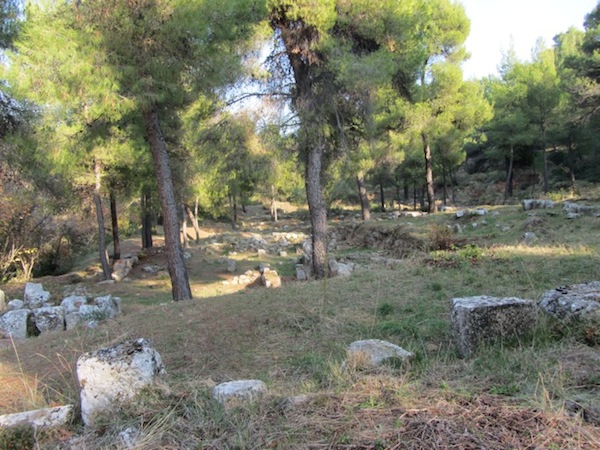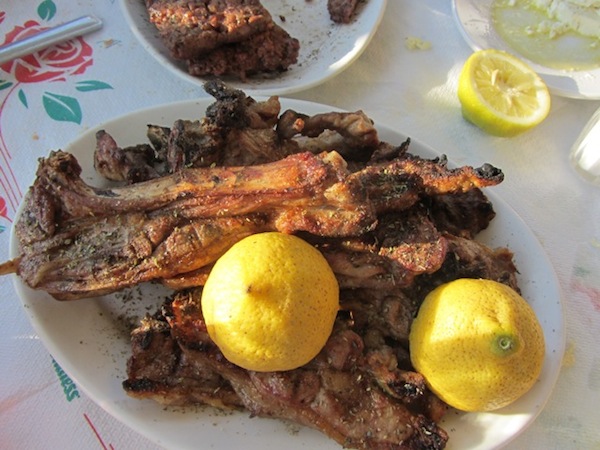An Outing in Attica, Greek Style
Eating Well Is The Best Revenge
by Diana Farr Louis
ATHENS Greece—(Weekly Hubris)—1/16/12—The plan should have been foolproof. We’d set out in separate cars, but the destination seemed straightforward enough. We’d meet at the ancient site of Amphiaraion, a center of healing like Epidaurus, though on a miniature scale, and then move on to a taverna for lunch.
But Greece is Wonderland, and nothing must ever be taken for granted.
For example, when an Athenian says Amphiaraion is her favorite place, you must not assume she knows how to get there. Or even knows which direction to take out of Athens.
It must be admitted, however, that our small, home-county of Attica can be confusing.
The night before, we’d clearly stated that the site is on the way to Markopoulo. But which Markopoulo? There’s a big village by that name just past the airport. And a small village with the same name, about half an hour’s drive to the north.
To give him credit, our friend’s partner, who was driving, has lived most of his life outside of Greece and did not even know of the existence of the second Markopoulo. And our friend, let’s call her Bella, had invited her best friend, Z, just arrived from the States, to join the party. The two were nattering away, so excited to be together again after six months, that they didn’t know or care in which direction they were heading.
JotP (my spouse), my son, dog (Zinnia), and I had already been at Amphiaraion for 20-30 minutes when my phone rang for the first time. “Umm,” said D, the chauffeur, “we got onto the Attica Highway and are at Markopoulo, but don’t know where the site is.”
“Ah-hah,” said I. “What were you doing going east when you should have been going north to the other Markopoulo?!”
“Other Markopoulo???”
“Never mind. Just turn around and get onto the National Road. Get off at Malakassa and head for Markopoulo. You’ll see signs for Amphiaraion about 3 km down the road.”
By this time, even the guard at Amphiaraion was in on the story, shaking his head. “Po, po, it’ll take them at least an hour and a half . . .” and he launched into an elaborate tale about other people who’d got lost.
Knowing we’d have a long wait, we started down the path to the site, Zinnia leading the way.
“Hey,” shouted the guard. “No dogs allowed. This is a sacred place.”
We’d suspected as much but, being the only visitors, we hoped to get away with it.
Zinnia tucked into the back seat, we reentered. Sunshine dusted the lichen-flecked marble pedestals lined up on the left. Then the ferocious whine of a drill shattered the silence. A gang of workmen were erecting a shelter for some special artifacts that have survived the wind and rain for 2,400 years. They operated in typical à la Grecque fashion: four supervisors and one laborer.
Fortunately, our arrival coincided with break time and, after a few more assaults to our ears, the team sat down on a wall under the pine trees and opened their sandwiches and beers.
Just then, a stray dog wandered into the area. Clearly at home, he made straight for the workers, who stroked him and handed out bits of bread.
This set the guard chasing after him. His authority undermined, he lost his cool and started shouting at the poor mutt, who zig-zagged around monuments and trees, tail between his legs . . . until, finally, he escaped out the gate, leaving our guard panting.
Apart from these minor disturbances, Amphiaraion remains idyllic: pines and cypresses, brown-leaved oaks and red-branched arbutus shade the old stones. It exudes such tranquillity that it’s just possible to imagine the sick who’d come here for a healing session, the altars draped with ex votos (very much like miraculous icons are today), the priests fishing coins of thanks out of the beneficial stream that still trickles through it.

As for the annual festivals and games, they probably resembled a modern soccer match. Then, crowds of spectators, hawkers and athletes would squeeze into this narrow vale where wrestling matches, pentathlons, and running races were held in honor of Amphiaraos, a seer-king of Argos who was one of the Seven Against Thebes. No stadium has been found. There is, though, a delectable little theater, which sat 300 with five thrones for bigwigs.
Years ago, maybe as many as 30, the Athens Singers—of which I was a member—gave an illicit performance of “Dido & Aeneas” there one evening in June. It was harder to maneuver the harpsichord down the stony path than to get permission. All we did was grease the guard’s palm with a thousand-drachma note and, the clincher, a demijohn of retsina.
The current guard, calmed down now that no canine posed a threat, remembered hearing about the occasion . . . and had continued the tradition, opening the gates for another concert years later.
Ours was like a midsummer night’s dream. Friends filled the ruined amphitheater, sipping from their own demijohns and nibbling from picnic hampers; kids played tag among the trees, and the sun set slowly, giving the signal for another chorus to begin—of nightingales and owls, crickets and frogs—that almost drowned out Purcell.
My phone rang again. “We’ve passed Markopoulo. Never saw the sign. We’re by the sea in Oropos,” said Bella. “That’s where the map shows Amphiaraion, just to the left of the port. But we can’t find it.”
“You can’t find it because that’s not where it is!” I rolled my eyes, but tried to explain patiently: “You have to come back up to Markopoulo, go through it, and then you’ll see the yellow and brown sign, on your left this time.”
By now it was well after 2 p.m. We’d revisited the theater and started our pilgrimage to the steeper part of the site, where an ancient water clock lies concealed above the stream. It brought back memories of even earlier visits with old friends when our children were small.
That’s Greece to me. So many layers of its own history combined with so many layers of my own.
The phone rang.
“Never mind about the site,” I said. “You’re never going to get here before it closes at 3. Just go to Markopoulo, find the main square, and sit in the taverna there. We’re coming.”
The three of us hustled back up to the car, where our dawg waited patiently. Markopoulo is just 5-10 minutes away. And as we approached, what we thought of as the main square but is really more like a bulge with a bus stop, a butcher’s, and two tavernes, we saw four figures waving at us from the churchyard above it.
Over lunch, and several doses of merciless teasing, D and Bella pulled out their maps. BOTH charts placed Amphiaraion on the coast and did not even agree where, to the right or left of Oropos. Moreover, when the pair got home, eager to defend themselves, they discovered that Google Earth sets Amphiaraion in the middle of the Gulf of Evia.
Never mind. Consolation awaited. The taverna, still a family affair, hads not changed in the years that we’ve known it. We sat in the sun, the only customers, and ordered everything on the non-menu. Establishments like this, one of the great and enduring benisons of Greece, never have a menu.
But they do have freshly chopped cabbage and carrot salad and hand-picked wild greens, soused in their own oil and lemon juice; feta from their own or a neighbor’s sheep; pyramids of tender young lamb chops, grilled to perfection; crisp fried potatoes; fantastic bread; and genuine retsina, a nearly extinct tradition. That’s what we ordered. But for starters, the kindly taverna owner bestowed upon us a platter of his own home-made sausages.

We guzzled and gnawed, emptying uncounted pitchers of wine and two stacks of chops. Throughout, Zinnia sat patiently under the table, hoping for spills. Her owner does not allow her to be fed while we’re eating, but I have the feeling Z was sneaking her tidbits.
It was another day to add to the memory scrapbook, a reaffirmation that the best things about Greece endure . . . and a reminder of how essential mobile phones are when touring Wonderland.
![]()
Recipe
Sausage Casserole from Mt. Pelion/Spetsofaï
There’s no point in giving you any instructions on how to recreate that meal, but I will tell you what I would have done with those sausages in my own kitchen.
For this, you don’t need exact amounts. Serve with lots of good bread, wine, and (anathema!) fried potatoes.
Ingredients
A couple of red or Vidalia onions, sliced
4-5 red bell or Florina peppers (or multicolored kerata/thin “horn” peppers), de-seeded and thickly cut
2-3 country sausages, in one-inch slices
olive oil
hot pepper flakes
tomato paste, heaping tablespoon or a couple of tomatoes, chopped
water or wine, red or white
Sauté the onions and peppers in plenty of oil until the onions are translucent. Add the sausages and cook, stirring, until slightly browned. Stir in the pepper flakes. Add the tomato paste diluted in a cup of water or wine or the tomatoes, and simmer, covered, until the vegetables are tender. You may need to add a little more liquid.
I also make this with eggplant—white are extra sweet—or zucchini, in addition to the peppers. It’s a very forgiving dish and very good, winter and summer.
4 Comments
barbara kalmoutis
SPETSOFAI!!!!… overwhelmed with nostalgia, to the point of tears….your descriptions are so perfect …Thank you. Love. Barbara
diana
Why not get your daughter to make it for you! Thanks, Barbara, as always for taking the trouble to read and write back. Your comments mean a lot to me. love, Diana
John Mole
Caught the spirit of Amphiaraion perfectly. Incidentally what is the origin of the name Spetsofai? Surely can’t come from Spetses. A chef from Piraeus once told me it was the favourite of a movie maker called Spentsos but I have my doubts. Lost in the mists of time?
Raita Sawyer
Darling Diana,
Do you remember that I struggled (in very high heels, teetering on them) with Bob to carry the harpsichord down the slope without dropping it and smashing it to smithereens? Ah, memories…. xxRaita